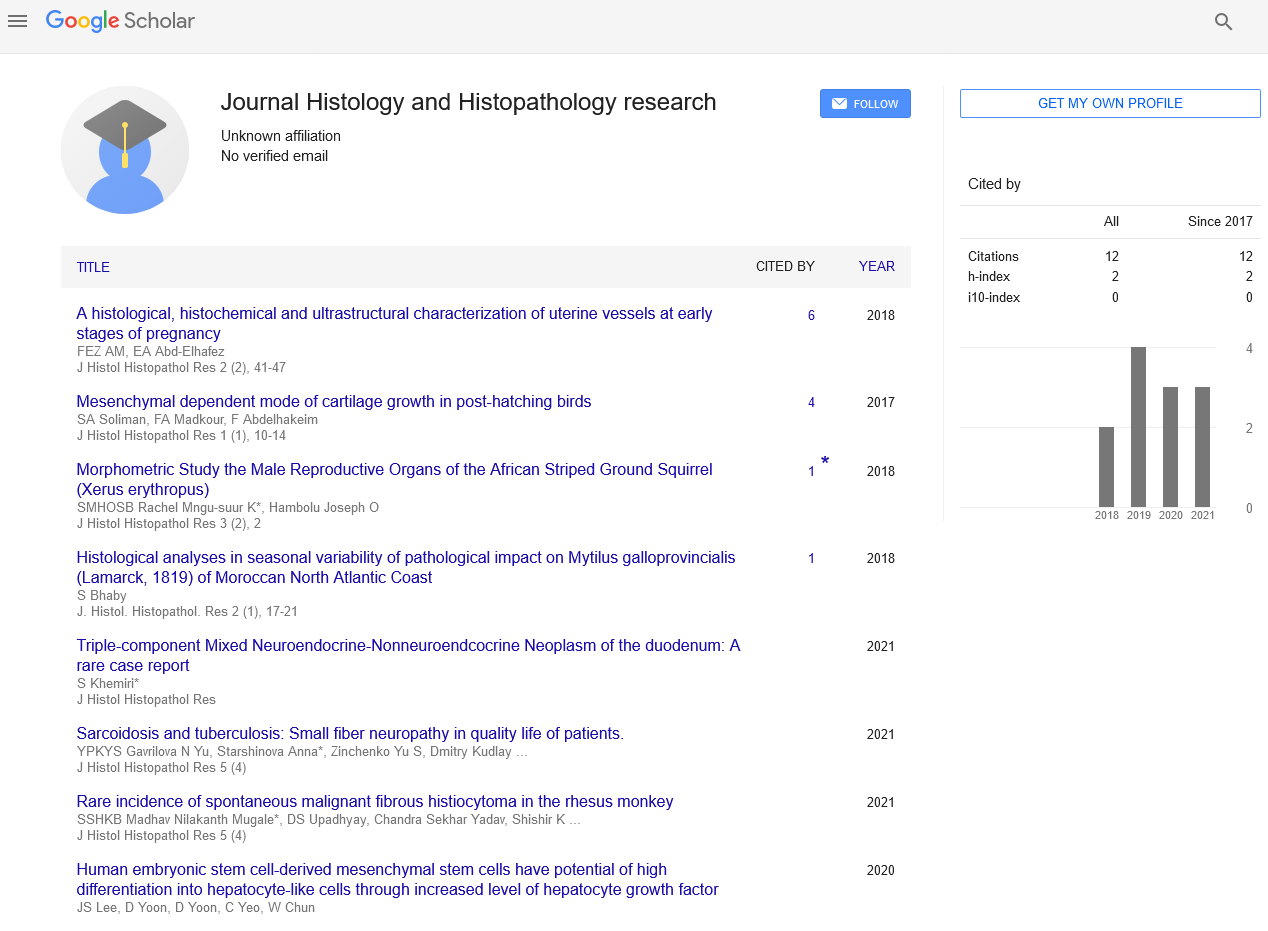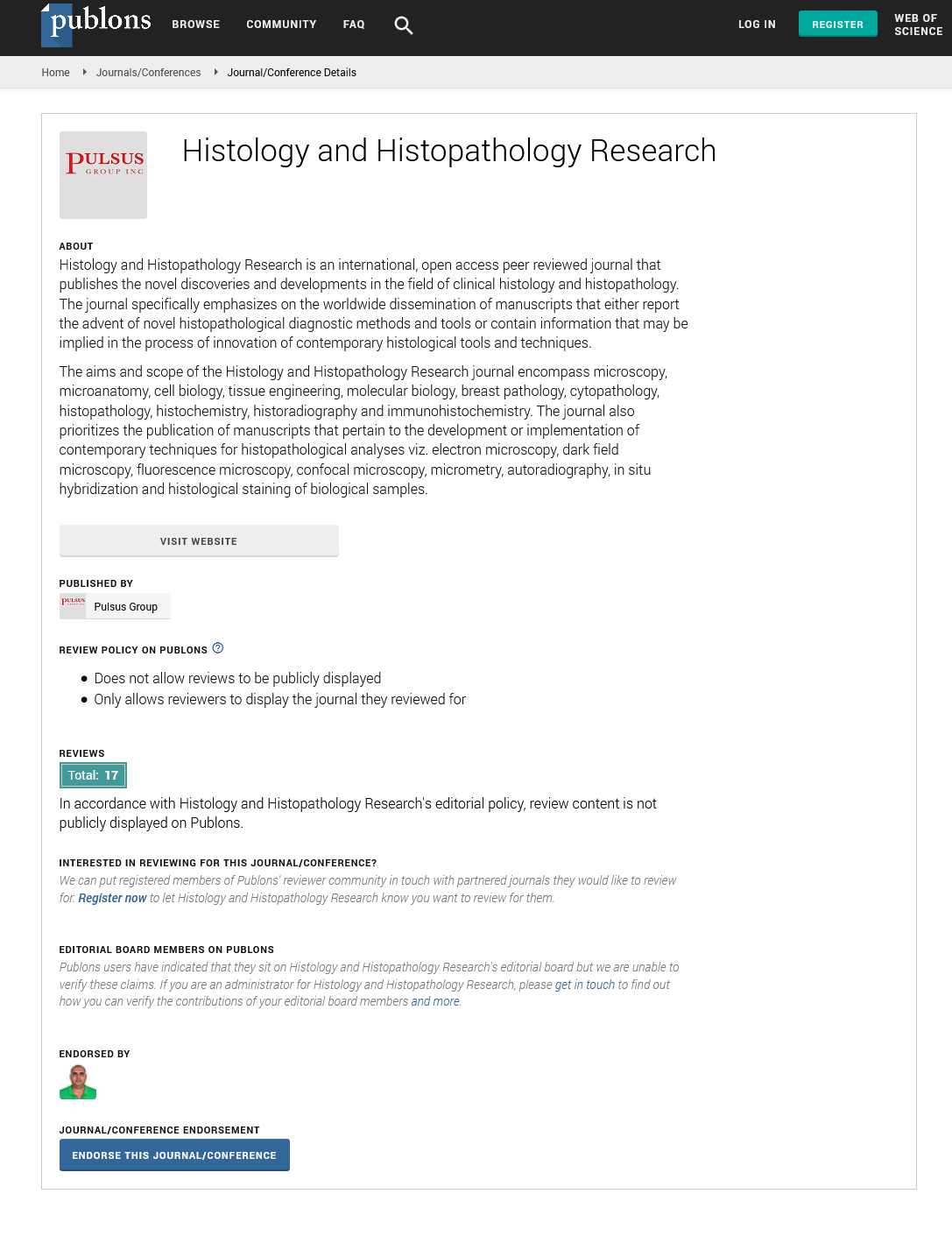Mesenchymal cells in cartilage growth, regeneration and replacement
Received: 21-Sep-2017 Accepted Date: Sep 26, 2017; Published: 30-Sep-2017
Citation: Soliman S. Mesenchymal cells in cartilage growth, regeneration and replacement. J Histol Histopathol Res. 2017;1(1):6-7.
This open-access article is distributed under the terms of the Creative Commons Attribution Non-Commercial License (CC BY-NC) (http://creativecommons.org/licenses/by-nc/4.0/), which permits reuse, distribution and reproduction of the article, provided that the original work is properly cited and the reuse is restricted to noncommercial purposes. For commercial reuse, contact reprints@pulsus.com
Maintenance a functional lifelong tissue requires a continual cellular turnover. Rate of turnover is thus carefully balanced with malfunctioned and dying cells. Physiological cell turnover predicates mostly on the resident terminally differentiated or stem cells. Terminally differentiated Cells may have a replication tendency enable them to propagate proliferating precursors. Most organs and tissues have their own stem or progenitor cells which retain capacity for differentiation. Directing Stem cells to the target destination depend on their niche and microenvironment. Certain factors exert their effect on stem cells to guide specific gene expression which in turn promote cellular propagation and differentiation [1].
Maintenance of cartilage depends primarily on perichondrial cells. Stimulation of perichondrial cells for chondrogenic differentiation yield proteoglycans-rich matrix around the whole circumference and expansion in diameter of the cartilage (Appositional growth of cartilage). Cartilage renewal is also accomplished by generation new cell progeny by chondrocytes division which produce new interstitial matrix (Interstitial growth of cartilage) [2].
Nature and structure of the articular cartilage render their regeneration difficult. Articular cartilage is not supplied by perichondrial stem cells. The terminally differentiated chondrocytes have a limited proliferative capacity. Hence, articular cartilage has a poor regenerative ability [3].
Several strategies have been developed for cartilage regeneration, However, many promising attempts have been made to gain articular hyaline cartilage that have adequate physical and chemical properties. The current article introduces an alternative type of cell, mesenchymal cell, that have been recently identified during cartilage growth, renewal and replacement during prenatal and postnatal life in different species. Cell identification is based on morphological, histochemical and immunophenotyping profile. Mesenchymal cells are small cells, have several cell processes which connect between mesenchymal cells. Mesenchymal cells are distinguished by expression of cell surface marker CD117 or C-kit. Transitional stages of chondrogenic cells express type II collagen; the basic fibrillar component of the cartilage matrix. Chondrogenic cells secrete cartilage-specific proteoglycan rich matrix. Mesenchymal cells have proteolytic enzymatic activities that enable them to penetrate the cartilage matrix. They have a strong MMP-9 immunoreactivity [4-6]. MMP-9 degrades collagen types IV, V, XIk´, XIVl´, elastin, aggrecan, link protein, decorinr, lamininn, entactin, SPARCq, myelin basic proteinm,∞2Mn, ∞1Pli, IL-1βj, proTNF-∞k [7].
Mesenchymal cells invade cartilage matrix of the air-breathing organ of catfish. Several sites of cellular invasive masses accompany vascular elements. Mesenchymal cells are originated from the perichondrial tissue or from the surrounded mesenchymal tissue. They acquired chondrogenic cell lineage and secrete an elastic type cartilage matrix. Hence, they participate in interstitial cartilage growth. Mesenchymal cells also are significant for cartilage renewal. They fill the spaces and lacunae that are left by the dying cells. The base of the air-breathing organ is supported by hyaline cartilage. Mesenchymal cells penetrate the hyaline cartilage where they commit proteolytic degradation of the existing cartilage matrix. Chondrogenic mesenchymal differentiation derives replacement of the hyaline cartilage by the elastic cartilage matrix. Therefore, mesenchymal cells provide the structural and functional maintenance of cartilage [4,8,9].
Cartilage canals are vascular tubes developed in the epiphyseal cartilage during embryonic life. They are originated from the perichondrial papillae [10]. Cartilage canals provide the epiphyseal cartilage with mesenchymal stem cell [11]. Immunotypic profile of cellular constituents of cartilage canals characterize type II collagen expressing cells [12,13] and type I collagen and, periostin expressing cells [11,14,15].
Mesenchymal cells are described in embryonic cartilage of avian and mammalian species. Mesenchymal invasion has been detected in the growing cartilage of different skeletal elements such as nasal, occipital, turbinate, lacrimal, sternum, frontal, premaxilla, maxilla, dentary, ribs, humerus, radius, ulna, femur, tibiotarsal, digit, vertebrae, clavicle. Mesenchymal invasion occurs in vascular-free areas. Undifferentiated mesenchymal cells are derived from perichondrium or from the encompassing mesenchyme where lack the perichondrium. Mesenchymal cells organization have a different pattern. They may be arranged as cellular masses of high and low cellular densities, packed as streaks of cells or oriented as a single mesenchymal cell. Mesenchymal streaks acquire different directions; parallel or randomly organized or in a bifurcated pattern. Mesenchymal-like cells are also mentioned in postnatal life. They are identified in the oropharyngeal cartilage of both duck and goose particularly cartilage of the middle nasal conchae, laryngeal cartilage and arytenoid cartilage and entoglossal cartilage. Mesenchymal cells represent chondrogenic potential precursors participate in interstitial growth of the developing cartilage [5,6].
In conclusion, invasion of mesenchymal cells during tissue growth considered a unique phenomenon. Several models have been introduced to study this phenomenon. Application of mesenchymal stem cells in tissue repair to be driven to their ultimate destination remain a hopeful purpose. Mesenchymal invasion phenomenon may provide a new therapeutic strategy for cartilage renewal. This should encourage Stem cell Technologies Scientist to discover signaling molecules and factors that attract mesenchymal-like cells and govern their chondrogenic differentiation.
REFERENCES
- Sanchez Alvarado A, Yamanaka S. Rethinking differentiation: stem cells, regeneration, and plasticity. Cell. 2014;157(1):110-9.
- Eroschenko VP, Fiore Mshd. DiFiore's Atlas of Histology with Functional Correlations. Lippincott Williams & Wilkins. 2013:114.
- Rai V, Dilisio MF, Dietz NE, et al. Recent strategies in cartilage repair: A systemic review of the scaffold development and tissue engineering. J Biomed Mater Res A. 2017;105(8):2343-54.
- Soliman SA, Abd-Elhafeez HH. Are C-KIT, MMP-9 and type II collagen positive undifferentiated cells involved in cartilage growth? A description of unusual interstitial type of cartilage growth. J Cytol Histol. 2016;7:440.
- Soliman SA, Abd-Elhafeez HH. Mesenchymal cells in cartilage growth and regeneration: An immunohistochemical and electron microscopic study. J Cytol Histol. 2016;7:437.
- Soliman SA, Abd-Elhafeez HH, Enas A. A new mechanism of cartilage growth in mammals, involvement of CD117 positive undifferentiated cells in interstitial growth. M J Cyto. 2017;1(1): 001.
- Clendeninn NJ, Appelt K. Matrix metalloproteinase inhibitors in cancer therapy. Springer Science+Business Media, New York. Humana Press. 2001.
- Soliman S. New aspect in cartilage growth: The invasive interstitial type. J Aquac Res Dev. 2014;5:253
- Soliman SA, Abd-elhafeez HH. Mesenchymal cells in cartilage growth. Lambert Academic Publishing, Germany. 2014;4:49.
- Gabner S, Häusler G, Böck P. Vascular channels in hyaline cartilage: development of channels and removal of matrix degradation products. Anat Histol Embryol. 2014;43:29.
- Blumer MJ, Schwarzer C, Perez MT, et al. Identification and location of bone-forming cells within cartilage canals on their course into the secondary ossification centre. J Anat. 2006;208(6): 695-707.
- Le Guellec D, Mallein-Gerin F, Treilleux I, et al. Localization of the expression of type I, II and III collagen genes in human normal and hypochondrogenesis cartilage canals. Histochem J. 1994;26(9): 695-704.
- Claassen H, Kirsch T, Simons G. Cartilage canals in human thyroid cartilage characterized by immunolocalization of collagen types I, II, pro-III, IV and X. Anat Embryol (Berl). 1996;194(2):147-153.
- Blumer MJ, Fritsch H, Pfaller K, et al. Cartilage canals in the chicken embryo: ultrastructure and function. Anat Embryol (Berl). 2004;207(6): 453-62.
- Blumer MJ, Longato S, Fritsch H. Cartilage canals in the chicken embryo are involved in the process of endochondral bone formation within the epiphyseal growth plate. Anat Rec A Discov Mol Cell Evol Biol. 2004;279(1):692-700.






